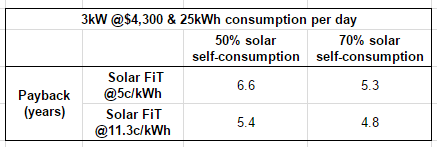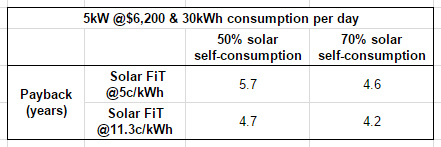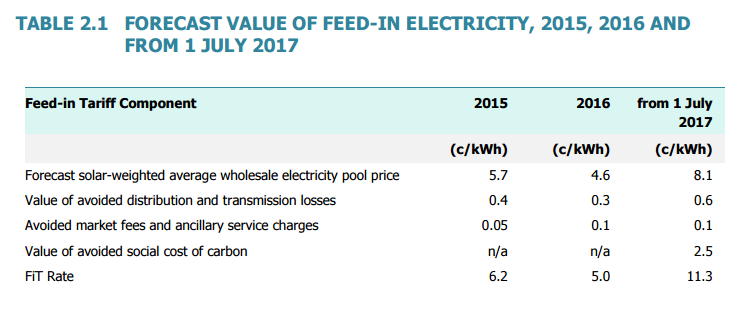The Victorian government has just made a move unprecedented in recent Australian solar history – they have moved to mandate a higher minimum solar feed-in tariff rate than what was previously on offer. From 1 July 2017, the new mandatory minimum rate for solar fed into the grid will be 11.3c per kilowatt-hour (kWh), up from 5c/kWh the previous year.
Why the increase?
The overarching trend over the last few years has been for states to reduce solar feed-in tariffs and/or remove mandatory minimum payments. The NSW and Queensland regulators, for example, haven’t mandated any minimum rate for years; instead, they leave electricity retailers to compete for solar customers with voluntary rates on an open market, with only ‘benchmark’ recommendations to light the way. South Australia recently did away with its mandatory minimum (the RFiT) as well.
Over the last two years in Victoria, the Essential Services Commission incorporated only wholesale electricity prices (i.e. the cost of ‘raw’ electricity on the National Electricity Market) and various avoided costs into their formula for determining solar feed-in rates. The first component comprised the vast majority of the feed-in tariff value (4.6c/kWh in 2016), while the latter odds & ends contributed only 0.4c/kWh.
Two things have changed in the ESC’s most recent determination. Firstly, they’ve forecast the wholesale electricity price at 8.1c/kWh. Secondly, they’ve added a new component that accounts for the ‘avoided social cost of carbon’ (which you can read more about in section 2.2 of the ESC’s final report). The regulator has put this component at 2.5c/kWh, bringing the full total to 11.3c/kWh.
Great news for Victoria’s solar homes
This is unequivocally good news for Victorians with pre-existing solar systems (but no generous feed-in tariff) and households thinking about going solar. At present the highest rate voluntarily offered in the state is 10c/kWh, but most retailers offer about 5-6c/kWh.
The higher rate will help to decrease solar PV system payback periods by about nine months, according to some rough calculations undertaken using our Solar System Payback Estimator Tool. In reality, however, outcomes will depend on a number of factors – most importantly the proportion of the solar energy used directly by the home (‘self-consumption‘). Even with the new, higher solar rate, households will still generally be better off using the solar energy themselves, but it will be slightly less crucial than under the older, lower rate.
The two tables below compare payback periods for 3kW and 5kW solar systems on the 5c/kWh and 11.3c/kWh rates, and under two solar self-consumption scenarios (50% vs 70%). As you can see, payback periods are shorter for the 70% scenarios than for the 50% scenarios, and the new, higher rate has less of an impact for homes that use most of their solar energy in the first place (n.b. achieving 70% self-consumption may require some extra effort, a solar hot water diverter or an automated energy management system).


Not-so-good news for retailers & market innovation
While the new minimum solar rate is unequivocally good for solar system owners, there is also the concern that the higher rate will stymie competition between retailers, and hamper innovation around creative ways to value solar & battery energy export into the grid (e.g. retailers who offer plans deploying Reposit Power’s GridCredits). Additionally, the costs of the rate increase are likely to be spread across non-solar customers on the retailers’ books – a ‘cross subsidy’ which may not pan out well with all voters. (Read more about the negatives in the Australian Financial Review – subscription only.)
Compare solar & battery installation quotes instantly
Compare Solar & Battery Quotes
© 2017 Solar Choice Pty Ltd
- Solar Hot Water System: Everything You Need to Know - 27 February, 2024
- Enphase Battery: An Independent Review by Solar Choice - 20 January, 2024
- Can I add more panels to my existing solar system? - 8 August, 2023

In the USA they get paid the same as it costs since it is green energy going in and mostly shit comming out.
The average bloke will never get a good price unless we form a collective and start suggesting they either look after us better or we shall start switch our roof top solar on and off in a uniform coordinated manner at the most inconvenient times to see if our input maters, and see if we can then negotiate as a collective that does matter…
Or better yet – you find a way to keep all your solar energy for yourself! Read more about solar self-consumption & shiftable loads.
Hi Shaun
Great article that explains the new Tarif well.
The other positive about Solar is the saving that you make in your electricity bill. If you have $7000 in the bank, you get a maximum 3% or $210 a year in interest, which you pay tax on.
Put that on your roof in the form of a solar panel systm and you will save far more than the $210 that this money generates in the bank. And this saving comes to you tax free. Same if you have money in a mortgage redraw account. It might reduce your interest bill a bit, but would be more useful in reducing your electricity bills.
Its pretty disgusting that we feed in at 6c/kwh and then have that power sold back to us at 26c/kwh – this move to up the minimum tariff is great but still not quite there. A value on something like energy should be fixed for both sides. If its worth 26c/kwh for them than it should be worth 26c/kwh for me. Why should power companies get richer from the average australian householders investment. Just seems unjust to me.
Hi Shaun,
The best way to make sure you get the most of your solar is to use it all yourself – energy management systems and hot water diverters can help homes to achieve this – as can battery storage (which is still pretty price, though).
You might also want to check out our article ‘Why doesn’t my retailer give me a 15c feed-in tariff?‘.